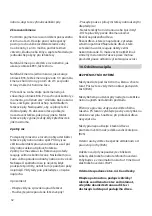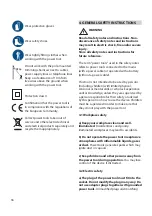
44
be able to estimate the falling direction of the
tree. Remove any dirt, stones, loose tree bark,
nails, clamps or wires from the tree.
Making a notch cut
Cut a notch into the tree which has a depth of 1/3
of the tree diameter. The notch must be at a right
angle to the falling direction of the tree. Always
make the horizontal cut of the notch first in order
to avoid jamming the saw chain or the saw guide
when making the second cut.
Making a felling cut
The felling cut must be made at least 50mm
above the horizontal notch cut, as shown in
illustration B31. The felling cut must be made
parallel to the horizontal notch cut. Cut until a
strip remains (felling strip) which can act as a
hinge. With this hinge, you can prevent the tree
from rotating and falling in the wrong direction.
Do not cut through this strip.
When the felling cut approaches the strip, the
tree will start falling. If you notice that the tree
does not fall in the desired direction, or that it
moves back, jamming the saw chain, the felling
cut must be interrupted. Insert wedges made of
wood, plastic or aluminium into the felling cut
in order to open the cut and make the tree fall in
the desired direction.
As soon as the tree starts falling, you must
remove the chainsaw from the cut, switch it off,
lay it down and leave the dangerous zone via
the planned escape route. Be aware of branches
falling down. Do not stumble.
Debranching
Debranching is the removing of branches from
the felled tree. Do not yet debranch major
branches pointing downwards and supporting
the tree. Remove minor branches with a cut (see
B32). Branches which are under tension must be
cut from the bottom to the top in order to avoid
jamming the saw.
Cutting to length
Cutting to length means separating the felled
tree into sections. Make sure that you are
standing safely on the ground with your weight
distributed on both feet. If possible, the tree
trunk must be supported by means of branches,
bars or wedges. Follow the instructions for easy
cutting.
If the entire length of the tree trunk is
appropriately supported as shown in illustration
B33, you can cut from above.
If the tree trunk is supported at one end, as
shown in illustration B34, you must first cut 1/3 of
the trunk diameter from the lower side, then cut
the rest of the tree trunk from the upper side at
the level of the lower cut.
If the tree trunk is supported on both ends, as
shown in illustration B35, you must first cut 1/3 of
the trunk diameter from the upper side, then cut
2/3 from the lower side at the level of the upper
cut.
When working on a slope, always stand above the
tree trunk, as shown in illustration B36. In order
to have full control at the moment of "cutting
through", you must reduce the pressure without
releasing the handles of the chainsaw. Make sure
that the saw chain does not touch the ground.
As soon as the cut is completed, you must wait
until the saw chain comes to a halt. Then you
can remove the chainsaw. Always switch off the
chainsaw before going to the next tree.
Kickback
A kickback occurs when the chainsaw is abruptly
thrown up and back. Kickbacks are caused if the
saw bar tip touches the work piece or if the saw
chain jams.
Kickbacks cause immediate forces with high
Summary of Contents for ES9021
Page 2: ...2 B1 7 3 1 2 6 8 9 5 13 17 10 11 18 14 16 15 13 6 11 10 ...
Page 3: ...3 B2 B3 B4 B6 B7 2 mm B8 B5 A 12 ...
Page 4: ...4 B9 B13 B14 B10 B12 B11 4 60o ...
Page 5: ...5 B16 B15 B17 B20 B19 B22 B21 B18 ...
Page 6: ...6 B24 B23 B25 B28 B27 B29 B26 A ...
Page 7: ...7 2 1 50 mm 50 mm C B31 B30 B32 B35 B34 B33 2 1 B36 ...
















































